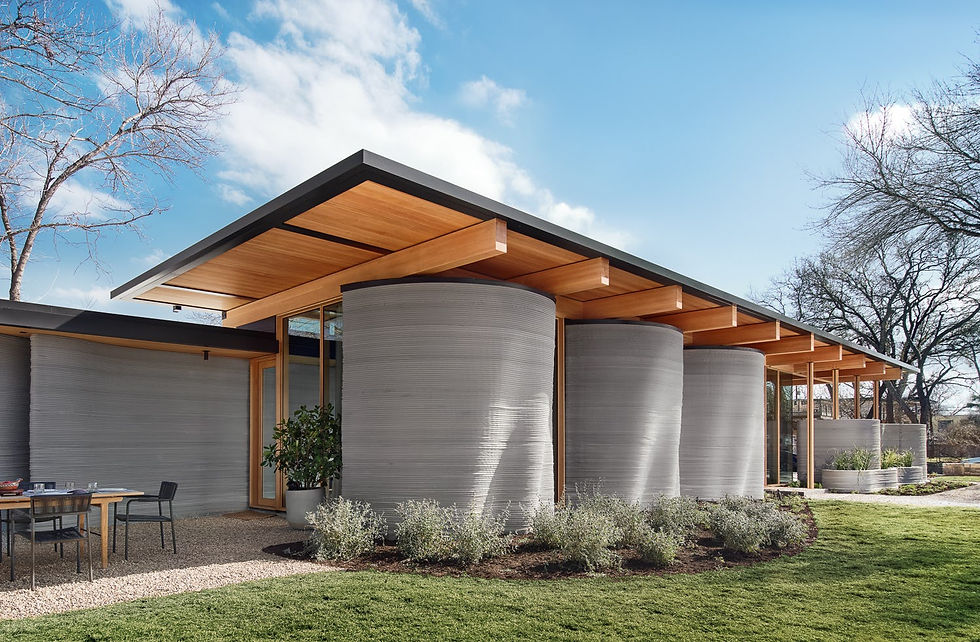I have previously explored some of the possibilities of 3D printing (see Pinch Me! Am I Dreaming? and It’s All Relative), which examined 3D applications for printed skin and large-scale rockets. This already seemed like something futuristic, as imagined in a Sci-Fi movie. However given the size and scope, I was not expecting 3D printed buildings to become a reality any time soon. This led me to the question, what is the future of sustainable building construction on Earth and beyond?

Photo: courtesy of ICON/BIG-Bjarke Ingels Group
Icon is a construction technology company based in Austin, Texas that seeks to disrupt the way we have been building houses since the 12th century. Instead of using “sticks and bricks", Icon uses 3D printers to create stronger houses out of piped-in-place concrete. While the idea of concrete houses seems rather limiting, the process by which Icon fabricates buildings results in more of a luxury hotel product. Currently, Icon is building desert-themed rooms for El Cosmico in Marfa, Texas. Previously, Icon has worked on building the Chicon house, the first ever permitted, 3D printed home in the United States; the Community First! Village, providing affordable, permanent housing for the homeless; a prototype rocket launch pad with NASA; US Military Barracks at Camp Swift; and House Zero, a luxury 3D printed house designed in conjunction with architectural firm Lake|Flato.

Photo: courtesy of ICON and Casey Dunn
Beyond Earth, Icon, in conjunction with NASA, is planning Project Olympus, which will allow for space-based construction systems to support exploration of the Moon and beyond. As you probably could understand, building a moonbase is very complicated. There is very little gravity on the Moon at approximately 1/6 of the Earth’s gravity; therefore, it is very hard to extrude concrete in the same way that is used on Earth. In addition, it is extremely difficult to send an entire house 3D-printing machine all the way to the Moon, not to mention the building materials including concrete powder and water necessary to construct a traditional 3D printed house. Due to these constraints, the team at Icon had to develop a new way to 3D print a moonbase, using only in-situ resources. Their ingenious plan involved a small lunar rover equipped with a high-power laser attached to a robotic arm. Once the rover arrived at the Moon via a commercial lander, it would drive autonomously to the selected build site. The rover would then use a built-in scooper to gather a small pile of lunar regolith (moondust), and a laser would heat up the regolith to create a small layer of solidified moondust. This process would be repeated until the entire structure was complete and habitable. Theoretically, this process could be used on Mars, and possibly even asteroids.

Photo: courtesy of Nasher Sculpture Center
In 2023, I had a chance to meet artist Patricia Johanson at the opening of Groundswell: Women of Land Art at the Nasher Sculpture Center. I was familiar with her large-scale sculptural work titled Dallas Fair Park Lagoon (1981-1986). It was in meeting Ms. Johanson and later corresponding that I learned that she was approached and almost joined a project to design space colonies. The inspiration for the commission originated from Gerald O’Neill’s The High Frontier, which has been the roadmap and blueprint of how to develop space colonies. O'Neill is considered the father of New Space and The High Frontier has also been the source of inspiration for NASA, Blue Origin and the National Space Society to build space colonies using available raw materials and existing technology. The good news is that technology is finally catching up with O'Neill's vision creating opportunities for the next generation of architects to develop buildings beyond Earth.




